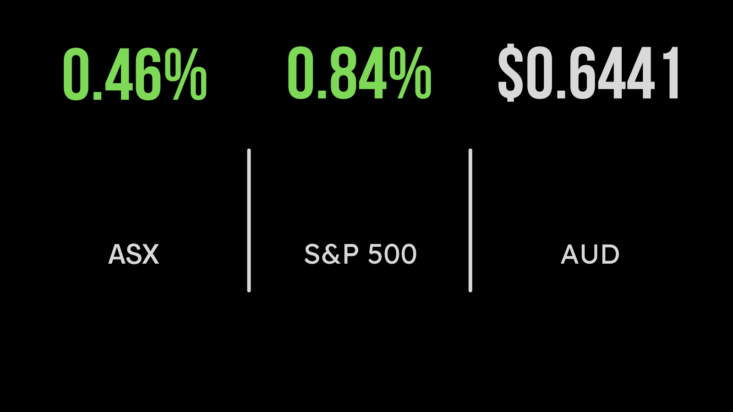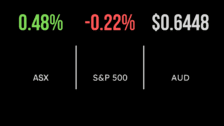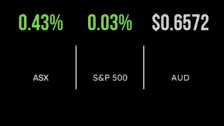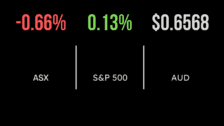Jobs data points to rate rise
After a stronger-than-expected US inflation figure for August, the Australian August job report blew expectations out of the water, with a 64,900 jobs created in the month, well above the 23,000 anticipated by economists. The unemployment rate stayed at 3.7 per cent in August. The data was viewed as boosting the case for the Reserve Bank to raise interest rates at least one more time, given the tight labour market. However, hours worked fell and the job growth was skewed towards part-time workers.
The S&P/ASX 200 gained 32 points, or 0.5 per cent, to 7,186, while the broader All Ordinaries Index also lifted 0.5 per cent, up 37 points to 7,382, as the indices gained impetus from iron ore, coal and uranium producers. Iron ore futures in Singapore pushed above $US120 per tonne, a six-month high, following a month-long rally that mow exceeds 20 per cent. In response, BHP rose 34 cents, or 0.8 per cent, to $44.14; Fortescue Metals gained 81 cents, or 4.1 per cent, to $20.41; and Rio Tinto jumped $2.06, or 1.8 per cent, to $115.45.
The Big Four banks all finished higher, with ANZ rising 27 cents, or 1.1 per cent, to $25.60; National Australia Bank advancing 33 cents, also 1.1 per cent, to $29.31; Commonwealth Bank gaining 43 cents, or 0.4 per cent, to $102.13; and Westpac adding 13 cents, or 0.6 per cent, to $21.62.
Uranium lights up market
In the energy sector, uranium producers and developers had a day out, after uranium prices hit a decade high on predictions of a doubling of demand by 2040, in a report from the World Nuclear Association. Bannerman Energy surged 24 cents, or 10.2 per cent, to a one-and-a-half-year high of $2.60; Boss Energy jumped 35 cents, or 8.8 per cent, to an all-time high of $4.32; Deep Yellow lifted 8 cents, or 8.3 per cent, to a one-year high of $1.05; and Namibia-based producer Paladin Energy gained 3.5 cents, or 3.9 per cent, to 93 cents.
Coal producers also enjoyed Thursday. Yancoal Australia rose 12 cents, or 2.5 per cent, to $5.02; Whitehaven Coal gained 21 cents, or 3.4 per cent, to $6.37; New Hope Corporation strengthened 15 cents, or 2.5 per cent, to $6.09; Coronado Global Resources moved 7 cents, or 4.2 per cent, to $1.745; and Stanmore Resources added 4 cents, or 1.3 per cent, to $3.12.
Elsewhere, drug developer Starpharma retreated 1 cent, or 6.3 per cent, to 15 cents, after positive interim results for the company’s cancer drug sent the shares up 20 per cent a day earlier. Infrastructure services company Downer EDI rose 6 cents, or 1.4 per cent, to $4.22 after securing a new contract from the Australian Defence Force valued at up to $750 million.
Bond market flashing red: US shares continue to ignore it
In the US, the Dow Jones Industrial Average rose the most in more than a month as traders cheered the revival of Wall Street’s IPO market, after chip design company Arm surged 25 per cent on debut. The Dow gained 331.58 points, or just under 1 per cent, to 34,907.11. The broader S&P 500 index was up 37.66 points, or 0.8 per cent, to 4,505.10, while the tech-heavy Nasdaq Composite index advanced 112.47 points, also 0.8 per cent, to 13,926.05.
US retail sales came in better than expected, lifting 0.6 per cent, well ahead of the 0.1 per cent increase expected by economists.
Many in the market, however, are convinced that the bond market continues to tell a different story: the US 10-year yield has now been below the 3-month yield for 212 trading days. That inversion is considered a recession warning: on some readings, the US bond market has not flashed a recession warning so consistently, for so long, in at least six decades.
Gold gained US$1.43, or 0.1 per cent, to US$1,910.52 an ounce. The global benchmark Brent crude oil grade surged US$1.82, or 2 per cent, to US$93.70 a barrel, while US West Texas Intermediate gained 42 cents, or 0.5 per cent, to US$90.58 a barrel.
The Australian dollar is buying 64.35 US cents, slightly weaker on the 64.42 cents it was buying at the ASX close on Thursday.











